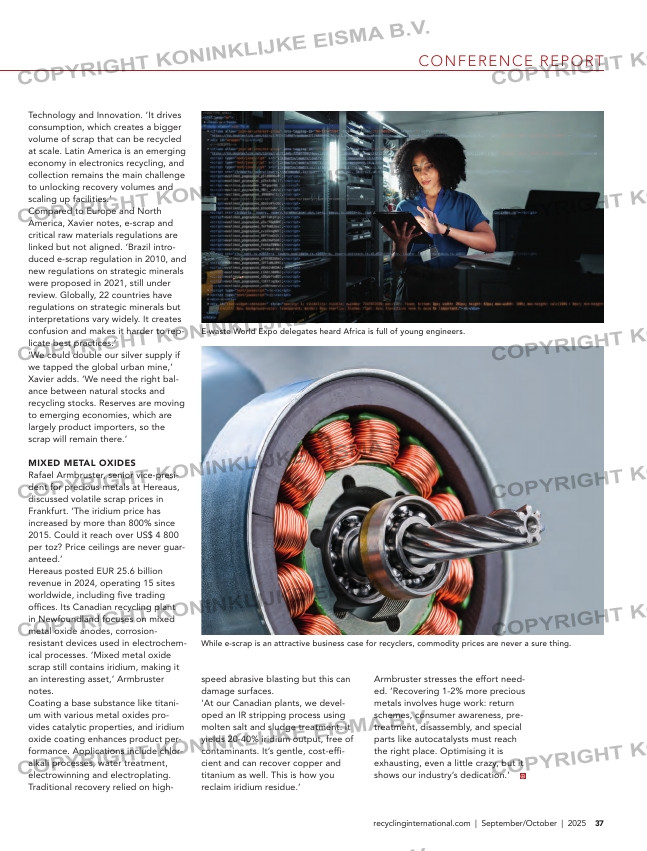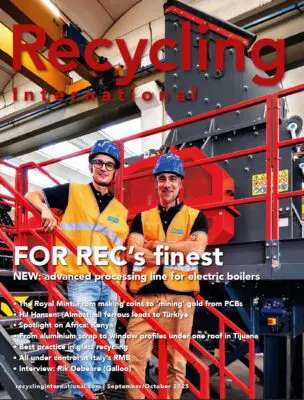Page 37 from: Recycling International September/October 2025

CONFERENCE REPORT
37recyclinginternational.com | September/October | 2025
stored cables. They were obviously
brand-new and likely to be heading
to a production facility. Lots of big
brands own factories in Ghana. I told
him to pack up and leave. I’m not
touching bad material.’
‘We want to do things the right way,
with the right people, with the right
paperwork. I know I’m one of many,
but sadly the positive stories don’t
make big headlines. Bad stories sell
better. I hope that by sharing my
story we can realise a better basis for
collaboration.’
‘There are a lot of young engineers in
Africa. They are skilled, curious and
driven. They give me hope for the
future of our tech sector.’
LATIN AMERICA’S CHALLENGE
‘Purchasing power is a deciding factor
for e-scrap,’ observes Lúcia Helena
Xavier, researcher at Cetem, part of
Brazil’s Ministry of Science,
Technology and Innovation. ‘It drives
consumption, which creates a bigger
volume of scrap that can be recycled
at scale. Latin America is an emerging
economy in electronics recycling, and
collection remains the main challenge
to unlocking recovery volumes and
scaling up facilities.’
Compared to Europe and North
America, Xavier notes, e-scrap and
critical raw materials regulations are
linked but not aligned. ‘Brazil intro-
duced e-scrap regulation in 2010, and
new regulations on strategic minerals
were proposed in 2021, still under
review. Globally, 22 countries have
regulations on strategic minerals but
interpretations vary widely. It creates
confusion and makes it harder to rep-
licate best practices.’
‘We could double our silver supply if
we tapped the global urban mine,’
Xavier adds. ‘We need the right bal-
ance between natural stocks and
recycling stocks. Reserves are moving
to emerging economies, which are
largely product importers, so the
scrap will remain there.’
MIXED METAL OXIDES
Rafael Armbruster, senior vice-presi-
dent for precious metals at Hereaus,
discussed volatile scrap prices in
Frankfurt. ‘The iridium price has
increased by more than 800% since
2015. Could it reach over US$ 4 800
per toz? Price ceilings are never guar-
anteed.’
Hereaus posted EUR 25.6 billion
revenue in 2024, operating 15 sites
worldwide, including five trading
offices. Its Canadian recycling plant
in Newfoundland focuses on mixed
metal oxide anodes, corrosion-
resistant devices used in electrochem-
ical processes. ‘Mixed metal oxide
scrap still contains iridium, making it
an interesting asset,’ Armbruster
notes.
Coating a base substance like titani-
um with various metal oxides pro-
vides catalytic properties, and iridium
oxide coating enhances product per-
formance. Applications include chlor-
alkali processes, water treatment,
electrowinning and electroplating.
Traditional recovery relied on high-
speed abrasive blasting but this can
damage surfaces.
‘At our Canadian plants, we devel-
oped an IR stripping process using
molten salt and sludge treatment. It
yields 20-40% iridium output, free of
contaminants. It’s gentle, cost-effi-
cient and can recover copper and
titanium as well. This is how you
reclaim iridium residue.’
Armbruster stresses the effort need-
ed. ‘Recovering 1-2% more precious
metals involves huge work: return
schemes, consumer awareness, pre-
treatment, disassembly, and special
parts like autocatalysts must reach
the right place. Optimising it is
exhausting, even a little crazy, but it
shows our industry’s dedication.’
E-waste World Expo delegates heard Africa is full of young engineers.
While e-scrap is an attractive business case for recyclers, commodity prices are never a sure thing.
34-35-36-37_escrapfrankfurtii12pagina.indd 37 09-09-2025 10:30



